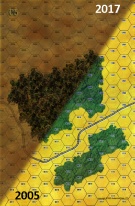|
|
|
Total |
| Side 1 |
1 |
| Draw |
1 |
| Side 2 |
0 |
|
Total |
| Side 1 |
1 |
| Draw |
1 |
| Side 2 |
0 |
|
Total |
| Side 1 |
0 |
| Draw |
0 |
| Side 2 |
0 |
|
| Overall Rating, 2 votes |
|---|
|
|
|
Scenario Rank:
--- of 964 |
| Parent Game |
Arctic Front |
| Historicity |
Historical |
| Date |
1942-02-07 |
| Start Time |
05:00 |
| Turn Count |
28 |
| Visibility |
Day |
| Counters |
63 |
| Net Morale |
1 |
| Net Initiative |
2 |
| Maps |
2: 1, 6 |
| Layout Dimensions |
56 x 43 cm
22 x 17 in |
| Play Bounty |
153 |
| AAR Bounty |
223 |
| Total Plays |
2 |
| Total AARs |
0 |
| Duplicates |
AFDx024 |
|
Introduction
|
|
The Soviet Maaselka offensive in January 1942 made substantial gains only in the sector of the 367th Rifle Division. When other Red Army formations failed to keep up with its advance, the exposed unit became a tempting target for the Finns. Despite Marshal Mannerheim's resolve to end offensive operations (over 100,000 Finnish soldiers were slated for furlough), the high command approved an attack.
|
|
Conclusion
|
|
Soviet ski troops had improved their skills greatly in the two years since their disastrous performance in the Winter War, but the small contingents scattered amid the encircled division could do nothing to save it. The Red Army troops sold their lives dearly, inflicting heavy casualties on the Finns, but in the end the 367th joined the roster of Soviet divisions forced into "motti" encirclements and wiped out.
|
Display Relevant AFV Rules
| AFV Rules Pertaining to this Scenario's Order of Battle |
- Vulnerable to results on the Assault Combat Chart (7.25, 7.63, ACC), and may be attacked by Anti-Tank fire (11.2, DFT). Anti-Tank fire only affects the individual unit fired upon (7.62, 11.0).
- AFV's are activated by tank leaders (3.2, 3.3, 5.42, 6.8).
They may also be activated as part of an initial activating stack, but if activated in this way would need a tank
leader in order to carry out combat movement.
- AFV's do not block Direct Fire (10.1).
- Full-strength AFV's with "armor efficiency" may make two anti-tank (AT) fire attacks per turn
(either in their action segment or during opportunity fire) if they have AT fire values of 0 or more
(11.2).
- Each unit with an AT fire value of 2 or more may fire at targets at a distance of between 100% and 150% of its
printed AT range. It does so at half its AT fire value. (11.3)
- Efficient and non-efficient AFV's may conduct two opportunity fires per turn if using direct fire
(7.44, 7.64).
Units with both Direct and AT Fire values may use either type of fire in the same turn as their opportunity fire,
but not both (7.22, 13.0).
Units which can take opportunity fire twice per turn do not have to target the same unit both times (13.0).
- Demoralized AFV's are not required to flee from units that do not have AT fire values (14.3).
- Place a Wreck marker when an AFV is eliminated in a bridge or town hex (16.3).
- AFV's do not benefit from Entrenchments (16.42).
- AFV's may Dig In (16.2).
- Open-top AFV's: Immune to M, M1 and M2 results on Direct and Bombardment Fire Tables, but DO take step losses from X and #X results (7.25, 7.41, 7.61, BT, DFT). If a "2X" or "3X" result is rolled, at least one of the step losses must be taken by an open-top AFV if present.
- APC – Armored Personnel Carrier: These are Combat Units, but stack like Transports. They can transport personnel units or towed units. They are not counted as combat units for the +1 stacking modifier on the Direct Fire and Bombardment Tables (4.4). They may be activated by regular leaders and tank leaders (1.2, 3.34, 4.3, 5.43). They do not provide the +1 Assault bonus (ACC).
|
Soviet Union Order of Battle
| 2 Errata Items |

|
The reduced direct fire value in Kursk: Burning Tigers is 4-4.
|

|
Propeller-driven APC on skis (aerosan). Treated as Foot units for movement purposes.
|






 AFro015
AFro015 




















